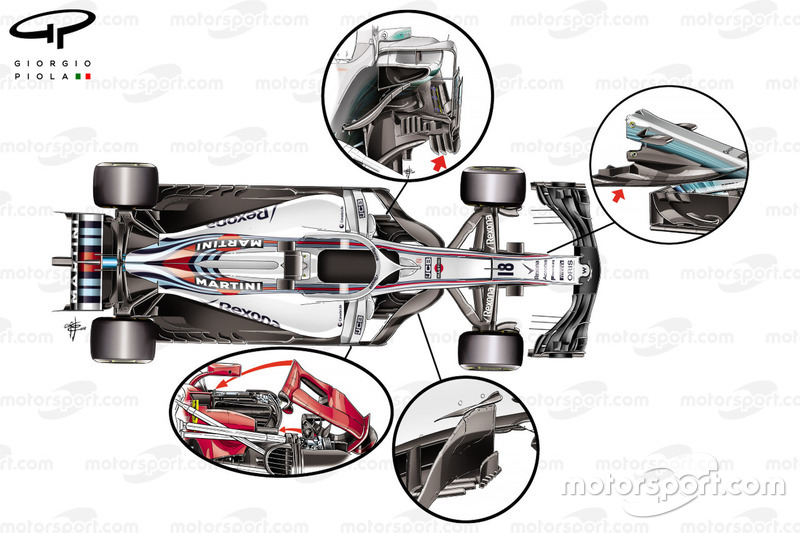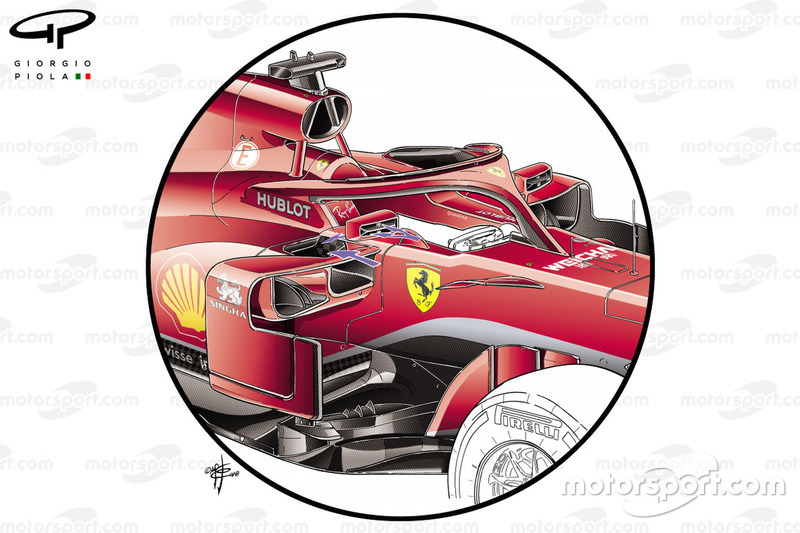What are F1's biggest design trends in 2018?
Whenever Formula 1 introduces dramatic new regulations, the first year of the rules always throws up some fascinating divergence as teams pursue different ideas.

Photo by: Giorgio Piola
Giorgio Piola's F1 technical analysis
Giorgio Piola is the preeminent Formula 1 technical journalist. View our full selection of Giorgio's technical illustrative content
As time passes, teams' designs converge more and more – as in the end they settle on what becomes an established best solution for that type of car.
The aerodynamic revamp we witnessed in 2017 was no exception to the rule as we saw some very different concepts up and down the grid – and even among the two main championship rivals.
Mercedes opted for a longer wheelbase low-rake concept with a high front suspension; while Ferrari was much shorter – and included a radical solution for the sidepods.
What was especially interesting about these differing ideas was that they were so central to the whole car, rather then being bolt-on bits, that nobody could go away and copy what they were doing during the season itself.
It was clear though that the winter just gone would provide an opportunity for these ideas to be implemented on 2018 cars – and that would give us the proof of which ideas were the actual best for these new regulations.
The clear winner from all of this was the Ferrari idea for the shorter sidepods – which has been copied by Red Bull, Williams, Sauber and, of course, Haas.
Ferrari's idea for the sidepods on its 2017 SF70H was ingenious and clearly delivered benefits that rival teams understood and felt they needed to pursue for 2018.
In a bid to minimise the overall area of the sidepods – which helps with drag and improves the management of airflow around the car – the team had to change designs in two areas.
This meant pushing the sidepod start area further back than had been normal before, and it also changed the height of the mandatory upper side impact support structure (seen in the inset above) – housing it ahead of the sidepod inlet rather than above it as had previously been the fashion.
It was a neat solution with clear aero benefits, and other teams have jumped on the idea and ensured that their cars go down a similar route – although some outfits have taken the idea to the next step.
Sauber goes more radical
Sauber's solution is interesting because it has moved the deformable structure so it is in the highest point allowed in the regulations – and, in doing so, the team has made it the cover inlet of its very small sidepods.
To get its sidepods as compact as possible it has divided the inlets too – so one is under the deformable structure, and then you can see there is a second inlet on top of the sidepods that is most likely to cool the electronics and intercooler.
This is going back to a solution that Mercedes tried out back in 2010. Despite some FIA attempts to control the matter, this idea was later pursued by Force India in 2011 and later Ferrari (see inset).
Sauber has also pursued the raised front suspension idea pioneered by Mercedes and Toro Rosso – so has taken the best bits of Ferrari and the best bits of Mercedes.
Williams cherry picking
The new Williams FW41 incorporates some key elements from both the Mercedes and Ferrari designs – as can be seen in the drawing above.
It has made its sidepods shorter than everybody else – and even shorter than last year's Ferrari. The sidepods on the FW41 start where the head protection of the driver starts.
Mercedes' solutions are in evidence here, too. It appears that everybody, for example, has acknowledged the benefits of a longer-wheelbase car – something Mercedes itself has stuck with for its 2018 challenger.
The new Williams, which is a big step on from last year's car, has adopted Mercedes' concept for its front wing and endplate – with the two outside opening gills in evidence.
Beneath the nose, Williams has designed its version of the Mercedes cape – which starts a bit further back compared to the original design.
The bargeboard area of the Williams is also reminiscent of the Mercedes W-floor design, with several 'fingers' helping direct airflow.
Back in 2016, when he was still at Mercedes, new Williams tech chief Paddy Lowe said he was surprised that few people had copied that idea, such were the benefits to be had.
McLaren's front wing a star
It isn't just the ideas of the championship frontrunners that have been pursued though.
Last year McLaren made a big push with its car design and was bullish about a new front wing concept that it introduced from the United States Grand Prix.
The wing idea – of having two slots in the mainplane – has been adopted by Ferrari for its 2018 challenger.
Furthermore, the McLaren idea of a front wing pillar that features three open slots has been taken on board by other teams now – with Ferrari, Toro Rosso and Renault all adopting this basic idea for their 2018 cars, even if the number of openings along the pillar varies.
We saw already last year that Williams copied the design from the Austrian GP.
New trends
F1 design is not just about copying the best from the rest though, and teams that set the benchmark often push on further as years go by.
It has been interesting to see that Mercedes has not copied anyone else, and has instead kept pushing down the path of its own solutions – opting for ever more complex concepts for ideas that it is convinced work best for it.
One of the best examples of this is the turning vane area, where is incredibly intricate now.
McLaren's new rear suspension has caught the eye in testing, as the team pushed the boundaries in a bid for aerodynamic advantage.
Ferrari has certainly not backed off with its innovation this year, even if its sidepods are not as extreme as last year as it has opted for a longer-wheelbase car.
One of the most interesting points on the car are the 'hollow' mirrors, which allow the airflow to pass inside and through the structure.
The benefit of this will be in helping direct airflow to the cooling areas that go inside the sidepods.
Don't rule out this idea appearing elsewhere soon...
Be part of Motorsport community
Join the conversationShare Or Save This Story
Subscribe and access Motorsport.com with your ad-blocker.
From Formula 1 to MotoGP we report straight from the paddock because we love our sport, just like you. In order to keep delivering our expert journalism, our website uses advertising. Still, we want to give you the opportunity to enjoy an ad-free and tracker-free website and to continue using your adblocker.



























Top Comments